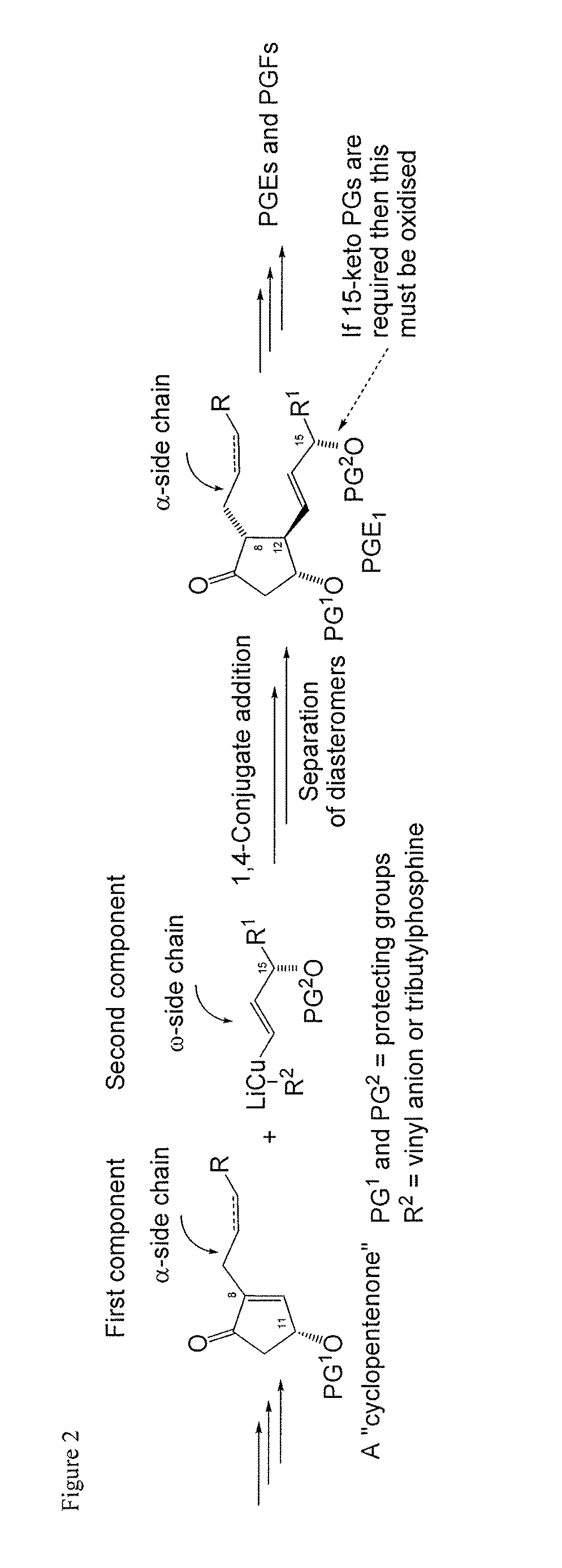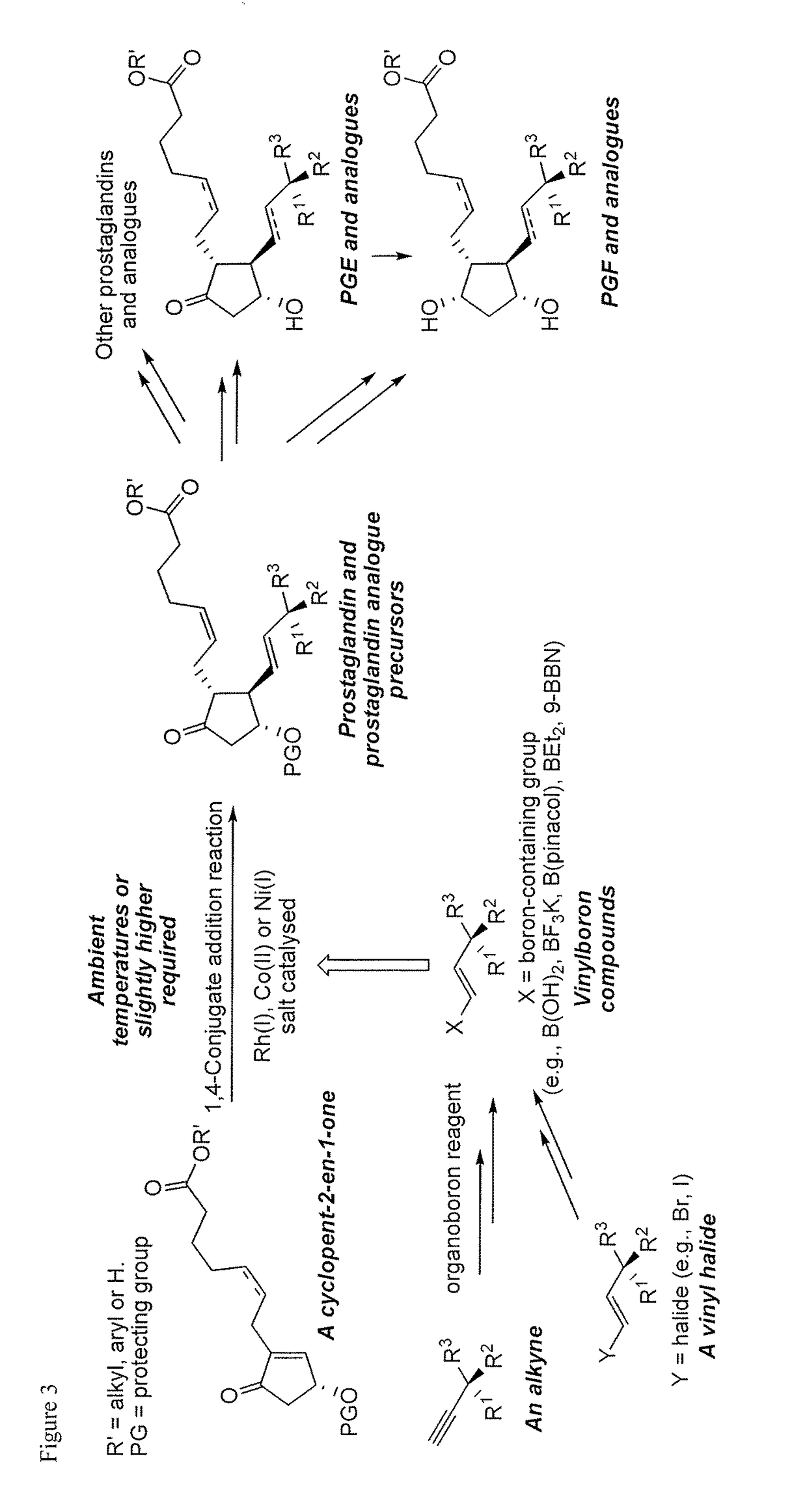Metal-catalyzed asymmetric 1,4-conjugate addition of vinylboron compounds to 2-substituted-4-oxy-cyclopent-2-en-1-ones yielding prostaglandins and prostaglandin analogs
a technology of cyclopent-2 and vinylboron, which is applied in the preparation of carbonyl compounds, organic chemistry, group 3/13 element organic compounds, etc., can solve the problems of high cost of corey lactone and the burdensome column chromatographic purification that are often required, use of reactive and difficult-to-manufacture organolithium compounds for the preparation of organocopper compounds, and high cost of corey lactone and the burdensome purification of chromatographi
- Summary
- Abstract
- Description
- Claims
- Application Information
AI Technical Summary
Problems solved by technology
Method used
Image
Examples
example 1
Synthesis of isopropyl (Z)-7-[(2R,3R)-3-(tert-butyl-dimethyl-silanyloxy)-5-oxo-2-styryl-cyclopentyl]-hept-5-enoate (10.1)
[0098]
[0099]A solution of isopropyl (Z)-7-[(3R)-3-(tert-butyl-dimethyl-silanyloxy)-5-oxo-cyclopent-1-enyl]-hept-5-enoate (2) (57 mg, 0.15 mmol), trans-2-phenylvinylboronic acid (3.1) (33 mg, 0.22 mmol), [RhCl(1,5-cyclooctadiene)]2 (1.1 mg, 2.2 μmol) and aq. KOH (9.5 μL, 3.0 M aq. KOH, 29 μmmol) in MeOH (1.0 mL) was stirred under microwave irradiation (CEM, Discover S; or Milestone, Startsynth; the temperature was set at 30° C.). After 5 hours, trans-2-phenylvinylboronic acid (3.1) (11 mg, 74 μmol) and [RhCl(1,5-cyclooctadiene)]2 (1.1 mg, 2.4 μmol) were added and the reaction mixture was stirred for another hour and was directly concentrated in vacuo. The residue was purified by column chromatography (eluting with 1:80 (v / v) acetone-hexanes) affording 10.1 (70 mg, 96%).
[0100][α]27D−57.4 (c 1.00, CHCl3); 1H NMR (400 MHz, CDCl3): δ 0.01 (s, 3H), 0.03 (s, 3H), 0.86 (s...
example 2
Synthesis of Isopropyl (Z)-7-[(1R,2R)-5-oxo-2,3-distyryl-cyclopent-3-enyl]-hept-5-enoate (6.1)
[0101]
[0102]The degradation product 6.1 standard can be prepared using the following procedure: A solution of 10.1 (16 mg, 33 μmol, trans-2-phenylvinylboronic acid (3.1) (9.2 mg, 62 μmol, [RhCl(1,5-cyclooctadiene)]2 (1.1 mg, 2.25 μmol, 5.6 mol %) and aq. KOH (9.5 μL, 3.0 M aq. KOH, 28.5 μmol) in MeOH (1 mL) was stirred at 60° C. After 12 hours, the mixture was directly concentrated in vacuo. The residue was purified by column chromatography (eluting with 1:80 (v / v) acetone-hexanes) affording the title compound 6.1 (13 mg, 86%).
[0103][α]24D−149.5 (c 0.46, CHCl3)); 1H NMR (400 MHz, CDCl3): δ 1.20 (d, J=6.4, 6H), 1.58-1.72 (m, 2H), 1.98-2.12 (m, 2H), 2.13-2.34 (m, 4H), 2.36-2.58 (m, 3H), 2.64-2.85 (m, 2H), 4.97 (septet, J=6.4 Hz, 1H), 5.31-5.50 (m, 2H), 6.06-6.22 (m, 2H), 6.43 (dd, J=11.6, 16.0 Hz, 2H), 7.17-7.36 (m, 10H); 13C NMR (100 MHz, CDCl3): δ 21.8 (CH3), 24.8 (CH2), 25.0 (CH2), 26.7 (C...
example 3
Synthesis of isopropyl (Z)-7-{(2R,3R),-3-(tert-butyl-dimethyl-silanyloxy)-2-[2-(4-methoxy-phenyl)-vinyl]-5-oxo-cyclopentyl}-hept-5-enoate (10.2)
[0104]
[0105]Following the procedure described in Example 1 the title compound was synthesized using trans-2-(4-methoxy-phenyl)-vinylboronic acid (3.2). The crude product mixture was then purified by column chromatography (eluting with 1:80 (v / v) acetone-hexanes) affording isopropyl (2)-7-{(2R,3R),-3-(tert-butyl-dimethyl-silanyloxy)-2-[2-(4-methoxy-phenyl)-vinyl]-5-oxo-cyclopentyl}-hept-5-enoate (10.2, 72 mg, 93%).
[0106][α]22D−50.6 (c 1.00, CHCl3); 1H NMR (400 MHz, CDCl3): δ 0.00 (s, 3H), 0.02 (s, 3H), 0.85 (s, 9H), 1.20 (d, J=6.3 Hz, 6H), 1.60-1.68 (m, 2H), 2.05 (dd, J=7.0, 14.1 Hz, 2H), 2.14-2.25 (m, 4H), 2.36-2.39 (m, 2H), 2.55-2.71 (m, 2H), 3.81 (s, 3H), 4.09 (dd, J=8.5, 15.8 Hz, 1H), 4.97 (septet, J=6.3 Hz, 1H), 5.32-5.45 (m, 2H), 5.89 (dd, J=8.4, 15.6 Hz, 1H), 6.44 (d, J=15.6 Hz, 1H), 6.85 (d, J=8.6 Hz, 2H), 7.28 (d, J=8.6 Hz, 2H); 13C ...
PUM
| Property | Measurement | Unit |
|---|---|---|
| temperature | aaaaa | aaaaa |
| cryogenic temperatures | aaaaa | aaaaa |
| temperature | aaaaa | aaaaa |
Abstract
Description
Claims
Application Information
 Login to View More
Login to View More - R&D
- Intellectual Property
- Life Sciences
- Materials
- Tech Scout
- Unparalleled Data Quality
- Higher Quality Content
- 60% Fewer Hallucinations
Browse by: Latest US Patents, China's latest patents, Technical Efficacy Thesaurus, Application Domain, Technology Topic, Popular Technical Reports.
© 2025 PatSnap. All rights reserved.Legal|Privacy policy|Modern Slavery Act Transparency Statement|Sitemap|About US| Contact US: help@patsnap.com



